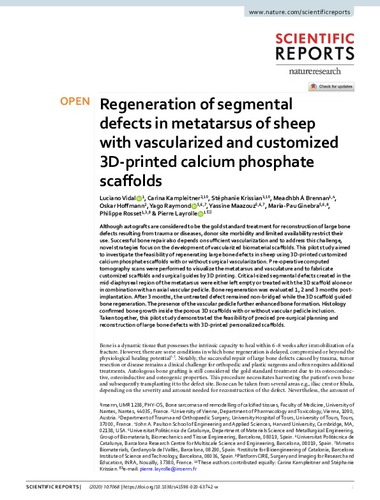Mostra el registre d'ítem simple
Regeneration of segmental defects in metatarsus of sheep with vascularized and customized 3D-printed calcium phosphate scaffolds
| dc.contributor.author | Vidal, Luciano |
| dc.contributor.author | Kampleitner, Carina |
| dc.contributor.author | Krissian, Stephanie |
| dc.contributor.author | Brennan, Meadhbh |
| dc.contributor.author | Hofmann, Oskar |
| dc.contributor.author | Raymond Llorens, Santiago |
| dc.contributor.author | Maazouz, Yassine |
| dc.contributor.author | Ginebra Molins, Maria Pau |
| dc.contributor.author | Rosset, P. |
| dc.contributor.author | Layrolle, P |
| dc.contributor.other | Universitat Politècnica de Catalunya. Doctorat en Ciència i Enginyeria dels Materials |
| dc.contributor.other | Universitat Politècnica de Catalunya. Departament de Ciència i Enginyeria de Materials |
| dc.date.accessioned | 2020-07-23T11:31:35Z |
| dc.date.available | 2020-07-23T11:31:35Z |
| dc.date.issued | 2020-04-27 |
| dc.identifier.citation | VIDAL, L. [et al.]. Regeneration of segmental defects in metatarsus of sheep with vascularized and customized 3D-printed calcium phosphate scaffolds. "Scientific reports", 27 Abril 2020, núm. 10, p. 7068:1-7068:11. |
| dc.identifier.issn | 2045-2322 |
| dc.identifier.uri | http://hdl.handle.net/2117/327488 |
| dc.description.abstract | Although autografts are considered to be the gold standard treatment for reconstruction of large bone defects resulting from trauma or diseases, donor site morbidity and limited availability restrict their use. Successful bone repair also depends on sufficient vascularization and to address this challenge, novel strategies focus on the development of vascularized biomaterial scaffolds. This pilot study aimed to investigate the feasibility of regenerating large bone defects in sheep using 3D-printed customized calcium phosphate scaffolds with or without surgical vascularization. Pre-operative computed tomography scans were performed to visualize the metatarsus and vasculature and to fabricate customized scaffolds and surgical guides by 3D printing. Critical-sized segmental defects created in the mid-diaphyseal region of the metatarsus were either left empty or treated with the 3D scaffold alone or in combination with an axial vascular pedicle. Bone regeneration was evaluated 1, 2 and 3 months post-implantation. After 3 months, the untreated defect remained non-bridged while the 3D scaffold guided bone regeneration. The presence of the vascular pedicle further enhanced bone formation. Histology confirmed bone growth inside the porous 3D scaffolds with or without vascular pedicle inclusion. Taken together, this pilot study demonstrated the feasibility of precised pre-surgical planning and reconstruction of large bone defects with 3D-printed personalized scaffolds. |
| dc.language.iso | eng |
| dc.publisher | Nature |
| dc.rights | Attribution-NonCommercial-NoDerivs 3.0 Spain |
| dc.rights.uri | http://creativecommons.org/licenses/by-nc-nd/3.0/es/ |
| dc.subject | Àrees temàtiques de la UPC::Enginyeria biomèdica::Biomaterials |
| dc.subject.lcsh | Bone regeneration |
| dc.title | Regeneration of segmental defects in metatarsus of sheep with vascularized and customized 3D-printed calcium phosphate scaffolds |
| dc.type | Article |
| dc.subject.lemac | Ossos -- Regeneració |
| dc.contributor.group | Universitat Politècnica de Catalunya. BBT - Biomaterials, Biomecànica i Enginyeria de Teixits |
| dc.identifier.doi | 10.1038/s41598-020-63742-w |
| dc.description.peerreviewed | Peer Reviewed |
| dc.relation.publisherversion | https://www.nature.com/articles/s41598-020-63742-w |
| dc.rights.access | Open Access |
| local.identifier.drac | 28837485 |
| dc.description.version | Postprint (published version) |
| dc.relation.projectid | info:eu-repo/grantAgreement/EC/H2020/779322/EU/Personalised maxillofacial bone regeneration/MAXIBONE |
| local.citation.author | VIDAL, L.; Kampleitner, C.; KRISSIAN, S.; Brennan, M.; Hofmann, O.; Raymond, S.; Maazouz, Y.; Ginebra, M.P.; ROSSET, P.; Layrolle, P. |
| local.citation.publicationName | Scientific reports |
| local.citation.number | 10 |
| local.citation.startingPage | 7068:1 |
| local.citation.endingPage | 7068:11 |
Fitxers d'aquest items
Aquest ítem apareix a les col·leccions següents
-
Articles de revista [734]
-
Articles de revista [156]
-
Articles de revista [439]


